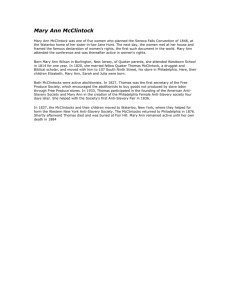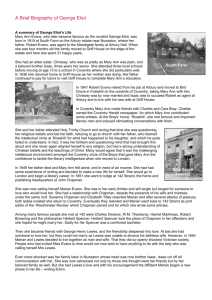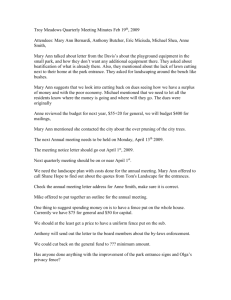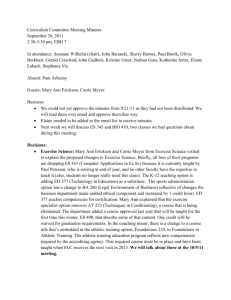George Eliot Biography
advertisement
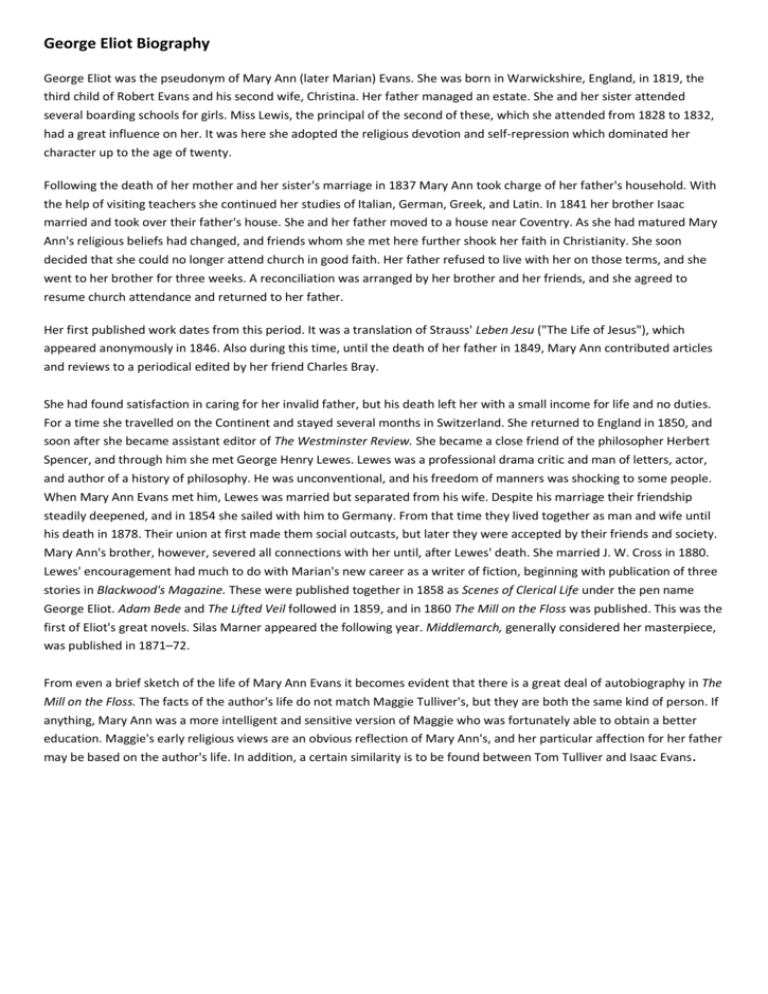
George Eliot Biography George Eliot was the pseudonym of Mary Ann (later Marian) Evans. She was born in Warwickshire, England, in 1819, the third child of Robert Evans and his second wife, Christina. Her father managed an estate. She and her sister attended several boarding schools for girls. Miss Lewis, the principal of the second of these, which she attended from 1828 to 1832, had a great influence on her. It was here she adopted the religious devotion and self-repression which dominated her character up to the age of twenty. Following the death of her mother and her sister's marriage in 1837 Mary Ann took charge of her father's household. With the help of visiting teachers she continued her studies of Italian, German, Greek, and Latin. In 1841 her brother Isaac married and took over their father's house. She and her father moved to a house near Coventry. As she had matured Mary Ann's religious beliefs had changed, and friends whom she met here further shook her faith in Christianity. She soon decided that she could no longer attend church in good faith. Her father refused to live with her on those terms, and she went to her brother for three weeks. A reconciliation was arranged by her brother and her friends, and she agreed to resume church attendance and returned to her father. Her first published work dates from this period. It was a translation of Strauss' Leben Jesu ("The Life of Jesus"), which appeared anonymously in 1846. Also during this time, until the death of her father in 1849, Mary Ann contributed articles and reviews to a periodical edited by her friend Charles Bray. She had found satisfaction in caring for her invalid father, but his death left her with a small income for life and no duties. For a time she travelled on the Continent and stayed several months in Switzerland. She returned to England in 1850, and soon after she became assistant editor of The Westminster Review. She became a close friend of the philosopher Herbert Spencer, and through him she met George Henry Lewes. Lewes was a professional drama critic and man of letters, actor, and author of a history of philosophy. He was unconventional, and his freedom of manners was shocking to some people. When Mary Ann Evans met him, Lewes was married but separated from his wife. Despite his marriage their friendship steadily deepened, and in 1854 she sailed with him to Germany. From that time they lived together as man and wife until his death in 1878. Their union at first made them social outcasts, but later they were accepted by their friends and society. Mary Ann's brother, however, severed all connections with her until, after Lewes' death. She married J. W. Cross in 1880. Lewes' encouragement had much to do with Marian's new career as a writer of fiction, beginning with publication of three stories in Blackwood's Magazine. These were published together in 1858 as Scenes of Clerical Life under the pen name George Eliot. Adam Bede and The Lifted Veil followed in 1859, and in 1860 The Mill on the Floss was published. This was the first of Eliot's great novels. Silas Marner appeared the following year. Middlemarch, generally considered her masterpiece, was published in 1871–72. From even a brief sketch of the life of Mary Ann Evans it becomes evident that there is a great deal of autobiography in The Mill on the Floss. The facts of the author's life do not match Maggie Tulliver's, but they are both the same kind of person. If anything, Mary Ann was a more intelligent and sensitive version of Maggie who was fortunately able to obtain a better education. Maggie's early religious views are an obvious reflection of Mary Ann's, and her particular affection for her father may be based on the author's life. In addition, a certain similarity is to be found between Tom Tulliver and Isaac Evans.
